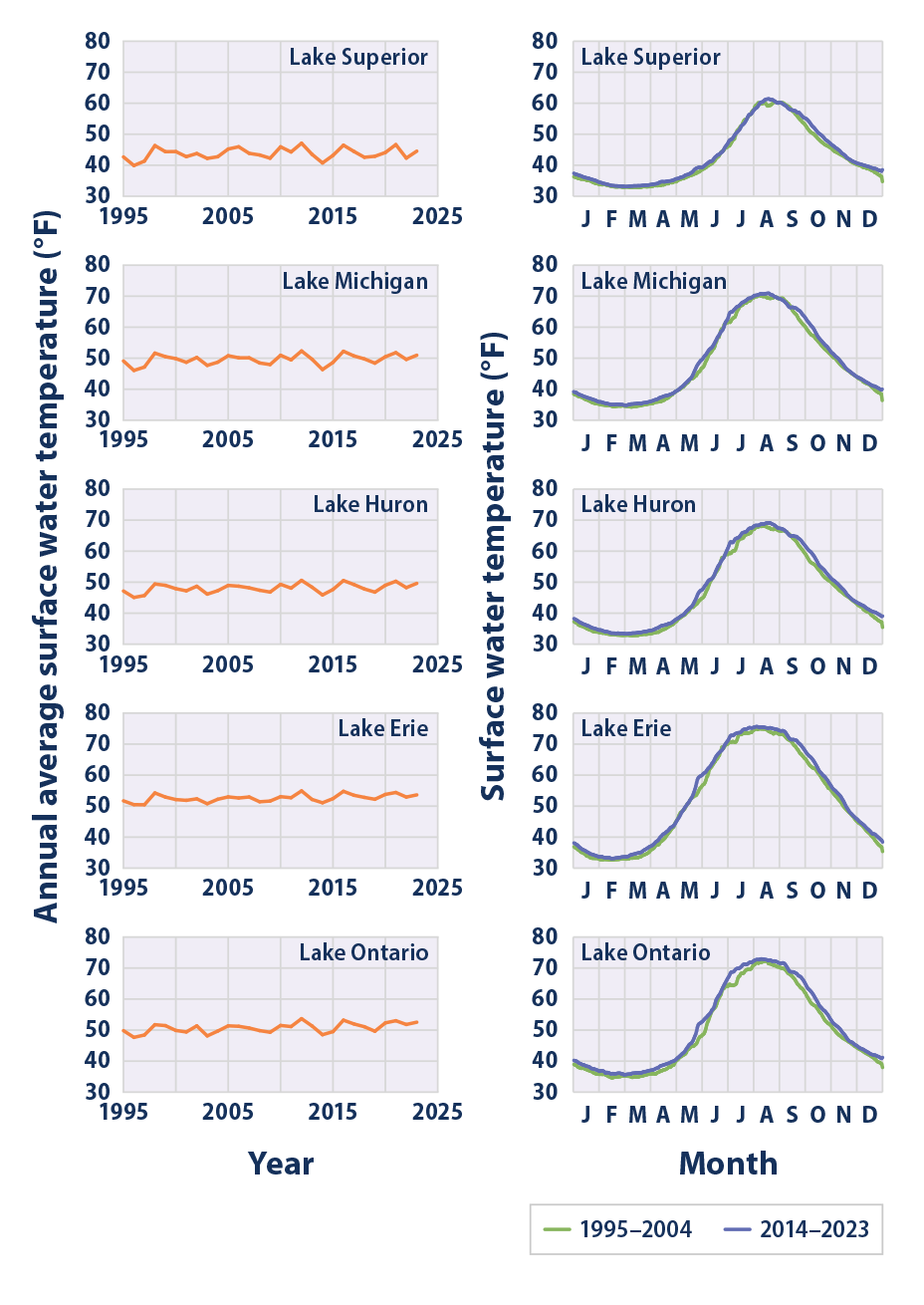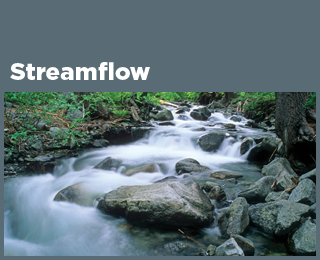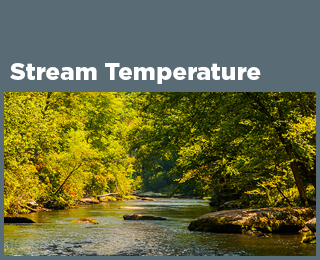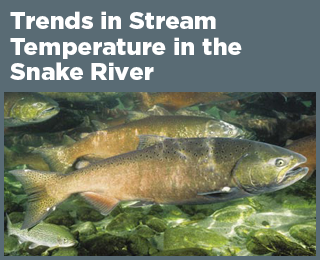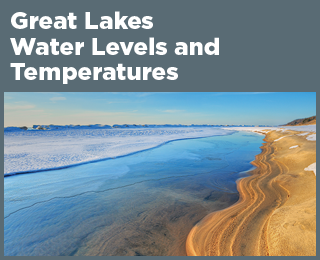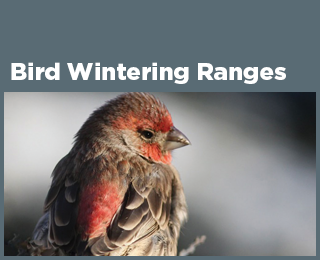Climate Change Indicators: Great Lakes Water Levels and Temperatures
This indicator measures water levels and surface water temperatures in the Great Lakes.
Key Points
- Water levels in the Great Lakes have fluctuated since 1860. Over the last few decades, water levels have declined slightly for most of the Great Lakes (see Figure 1). The past few years, however, have shown notable increases toward the top of the historical range. At the end of 2023, water levels sat slightly above average for all of the Great Lakes.
- Since 1995, average surface water temperatures have increased slightly for each of the Great Lakes (see Figure 2).
- Recent increases in water temperature have mostly been driven by warming during the spring and summer months (see Figure 2). These trends could relate in part to an earlier thawing of winter ice (see the Lake Ice indicator).
Background
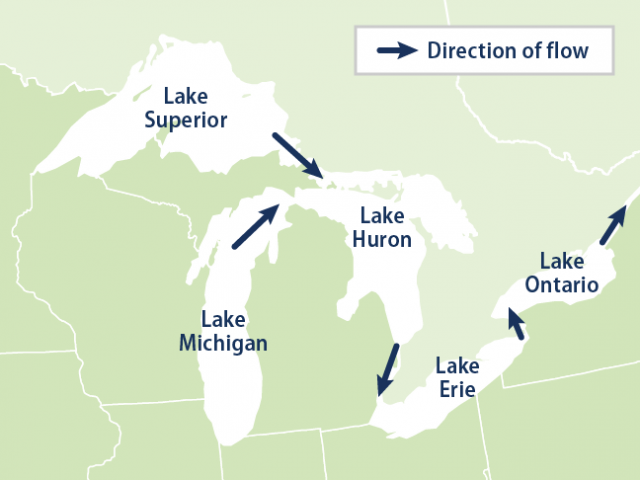
Water level and water temperature are two important and interrelated indicators of weather and climate change in the Great Lakes. Water level (the height of the lake surface above sea level) is influenced by many factors, including precipitation, snowmelt runoff, drought, evaporation rates, and people withdrawing water for multiple uses. Water temperature is influenced by many factors, too, but most directly by air temperature.
In some recent years, high precipitation has contributed to higher-than-average and sometimes record-breaking water levels in the Great Lakes.1 In other recent years, warmer surface water temperatures in the Great Lakes have contributed to lower water levels by increasing rates of evaporation and causing lake ice to form later than usual (see the Lake Ice indicator), which extends the season for evaporation.2,3 Lower water levels in the Great Lakes forced ships to reduce their cargo tonnage by 5 to 8 percent between 1997 and 2000, which increased shipping costs.4 Lower water levels can also affect water supplies, the usability of infrastructure such as docks and piers, and shoreline ecosystems. Scientists who use computer models to simulate future climate change are not sure whether Great Lakes water levels will increase or decrease overall in the future, but they generally agree that there will be larger year-to-year variability, driven by periods of drought and extreme precipitation.1
Another possible effect of warmer water, reduced ice cover, and increased evaporation is a corresponding increase in precipitation over nearby land, especially “lake effect” snow (see the Snowfall indicator).5 Rising water temperatures are also expected to expand the ranges of and give new advantages to some invasive species such as the zebra mussel, and to encourage the growth of certain waterborne bacteria that can make people ill.6,7
About the Indicator
This indicator analyzes water levels and surface water temperatures in the Great Lakes. Water levels are recorded by gauges along the shore of each lake, some of which have been operated since the 1800s. Pre-1918 data came from one water level gauge per lake. Data since 1918 have come from a designated set of gauges in each lake. Figure 1 shows annual water level anomalies in each lake from 1860 to 2023; anomalies are differences, in feet, compared with a baseline (in this case, the 1981–2010 average). Lakes Michigan and Huron are combined because they are connected at the same water level.
Surface water temperatures are measured by satellites. Figure 2 shows annual average temperatures over the entire surface of each lake, along with the pattern of daily temperatures over the course of the year. This figure’s data begin in 1995, which was the first year with complete satellite data for all five lakes.
About the Data
Indicator Notes
While climate change influences water levels, human activities such as dredging can also play a role. For example, the St. Clair River opening was enlarged in the 1910s, 1930s, and 1960s, contributing to greater outflows from Lakes Michigan and Huron.10 Similarly, natural year-to-year variability and other factors such as human use and wastewater discharges can influence water temperatures.
Data Sources
Water level data were provided by the Canadian Hydrographic Service and the National Oceanic and Atmospheric Administration’s Center for Operational Oceanographic Products and Services, and can be downloaded from: www.glerl.noaa.gov/data/wlevels/dashboard/. Surface water temperature data were provided by the National Oceanic and Atmospheric Administration’s Great Lakes Environmental Research Laboratory (satellite data at: https://apps.glerl.noaa.gov/erddap/info/glsea-avgtemps2/index.html).
Technical Documentation
References
1 Lamie, C., Bader, D., Graziano, K., Horton, R., John, K., O’Hern, N., & Spungin, S. (2024). Chapter 2: New York State’s Changing Climate. In New York State Climate Impacts Assessment (Interim version for public release).
2 Gronewold, A. D., Fortin, V., Lofgren, B., Clites, A., Stow, C. A., & Quinn, F. (2013). Coasts, water levels, and climate change: A Great Lakes perspective. Climatic Change, 120(4), 697–711. https://doi.org/10.1007/s10584-013-0840-2
3 Wilson, A. B., Baker, J. M., Ainsworth, E. A., Andresen, J., Austin, J. A., Dukes, J. S., Gibbons, E., Hoppe, B. O., LeDee, O. E., Noel, J., Roop, H. A., Smith, S. A., Todey, D. P., Wolf, R., & Wood, J. D. (2023). Chapter 24: Midwest. In USGCRP (U.S. Global Change Research Program), Fifth National Climate Assessment. https://doi.org/10.7930/NCA5.2023.CH24
4 Posey, J. (2012). Climate change impacts on transportation in the Midwest. In U.S. National Climate Assessment: Midwest Technical Input Report. Great Lakes Integrated Sciences and Assessments (GLISA). http://glisa.msu.edu/docs/NCA/MTIT_Transportation.pdf
5 Burnett, A. W., Kirby, M. E., Mullins, H. T., & Patterson, W. P. (2003). Increasing Great Lake–effect snowfall during the twentieth century: A regional response to global warming? Journal of Climate, 16(21), 3535–3542. https://doi.org/10.1175/1520-0442(2003)016<3535:IGLSDT>2.0.CO;2
6 Rahel, F. J., & Olden, J. D. (2008). Assessing the effects of climate change on aquatic invasive species. Conservation Biology, 22(3), 521–533. https://doi.org/10.1111/j.1523-1739.2008.00950.x
7 Kanoshina, I., Lips, U., & Leppänen, J.-M. (2003). The influence of weather conditions (temperature and wind) on cyanobacterial bloom development in the Gulf of Finland (Baltic Sea). Harmful Algae, 2(1), 29–41. https://doi.org/10.1016/S1568-9883(02)00085-9
8 NOAA (National Oceanic and Atmospheric Administration) Great Lakes Environmental Research Laboratory. (2024). Great Lakes water level dashboard. Retrieved March 14, 2024, from www.glerl.noaa.gov/data/wlevels/dashboard
9 NOAA (National Oceanic and Atmospheric Administration). (2024). NOAA CoastWatch Great Lakes node. Retrieved March 14, 2024, from https://apps.glerl.noaa.gov/erddap/index.html
10 Quinn, F. H. (1985). Temporal effects of St. Clair river dredging on lakes St. Clair and Erie water levels and connecting channel flow. Journal of Great Lakes Research, 11(3), 400–403. https://doi.org/10.1016/S0380-1330(85)71784-4


